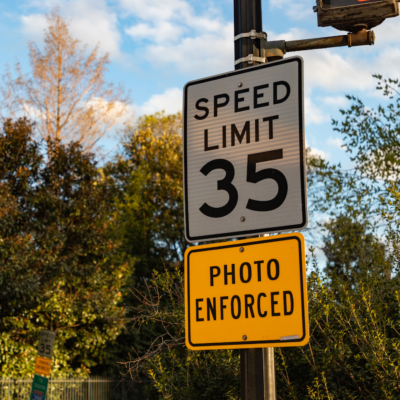On August 6, 2021, the default speed limit for downtown and residential roads in Edmonton was reduced from 50km/h to 40km/h. The idea was to apply a speed limit that would significantly impact safety while not significantly affecting travel time. Another positive effect of this speed reduction is lessening noise in residential areas.
But is such a speed limit decrease effective? What have the results been in other cities where speed limits were reduced?
Statistics
When we look at available statistics, we can see how driving speed and accidents (as well as deaths and serious injuries from accidents) are connected. Once we understand this connection, we can see whether reducing the speed limit is a good idea.
Here are some of the data that we found:
- Increasing your speed by 16km/h increases your risk of a car crash by almost 10%
- The number of car accidents goes down by 5% for each 1.6km/h decrease in speed, up to a certain threshold
- Speeding is the root cause of nearly one-third of all motor vehicle accidents in Canada
- If a person is hit by a car that’s driving 50km/h, they are nearly six times more likely not to survive the accident than a person who is hit by a car driving at a speed of 30km/h
Based on these statistics alone, we can see that there is a strong connection between driving at higher or lower speeds and the effect on how many accidents there are, as well as how serious the outcomes of these accidents are.
Are there examples of places that have reduced the speed limit?
mmmmmmmmmmmmm
Other Examples
There are several other cities around Canada, as well as other places internationally, that have reduced their speed limits (especially on local or urban roads).
One of these cities is Toronto. A study on reducing the speed limit down to 30km/h on neighbourhood streets in Toronto showed a 28% reduction in accidents between cars and pedestrians. However, an even more significant change was noted in how badly pedestrians were injured. At a speed limit of 30km/h, there was a 67% reduction in how many individuals struck by cars were injured severely or killed.
Quebec City is another Canadian city that reduced its speed limits a few years ago. A study found that decreasing the speed limit by 20km/h resulted in 3% fewer accidents that ended in serious injury or death.
mmmmmmmmmmmmm
The International Transport Forum (ITF) has also released information showing the connection between driving speed, accidents, and injuries, as well as examples of other countries that have decreased driving speeds.
One such example is Hungary. The speed limit in urban areas was reduced by 8%, and the number of deaths due to car accidents went down by 18%. On the other hand, when Hungary increased speed limits on rural roads by 2.5%, deaths went up by 13%.
Successful Implementation
The data shows us that driving slower tends to result in fewer accidents and less deaths or serious injuries. However, an important fact to remember is that just decreasing the speed limit does not automatically lead to these improvements. Nothing happens unless drivers actually follow the posted speed limit.
This is why education is such a critical part of a change in speed limit. If people are aware of the big difference this change in their driving can make, and also understand how serious things can get when they ignore the speed limit, they are more likely to stick to the speed limit.
mmmmmmmmmmmmm
If you have been injured in a car, truck, motorcycle or other vehicle accident, give us a call. We have years of experience in working with clients who have suffered injuries in motor vehicle accidents, and we know how to fight for the compensation you deserve.
At McGuiness Law, we are happy to offer you a free, no-obligation consultation to offer you guidance and to see if you would benefit from working with us. Our phone number is 780-900-7941, or you can reach us through our online contact form by clicking HERE.